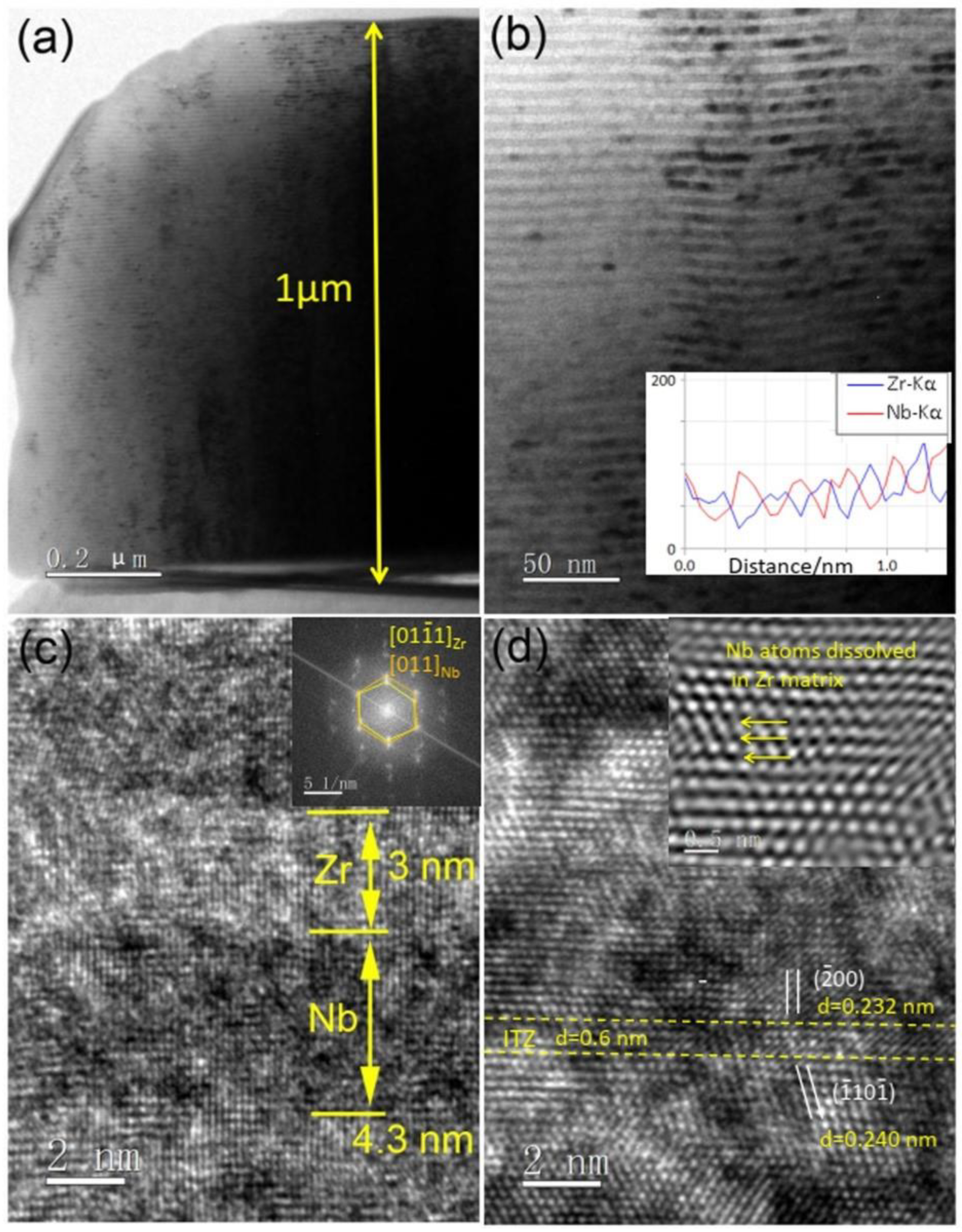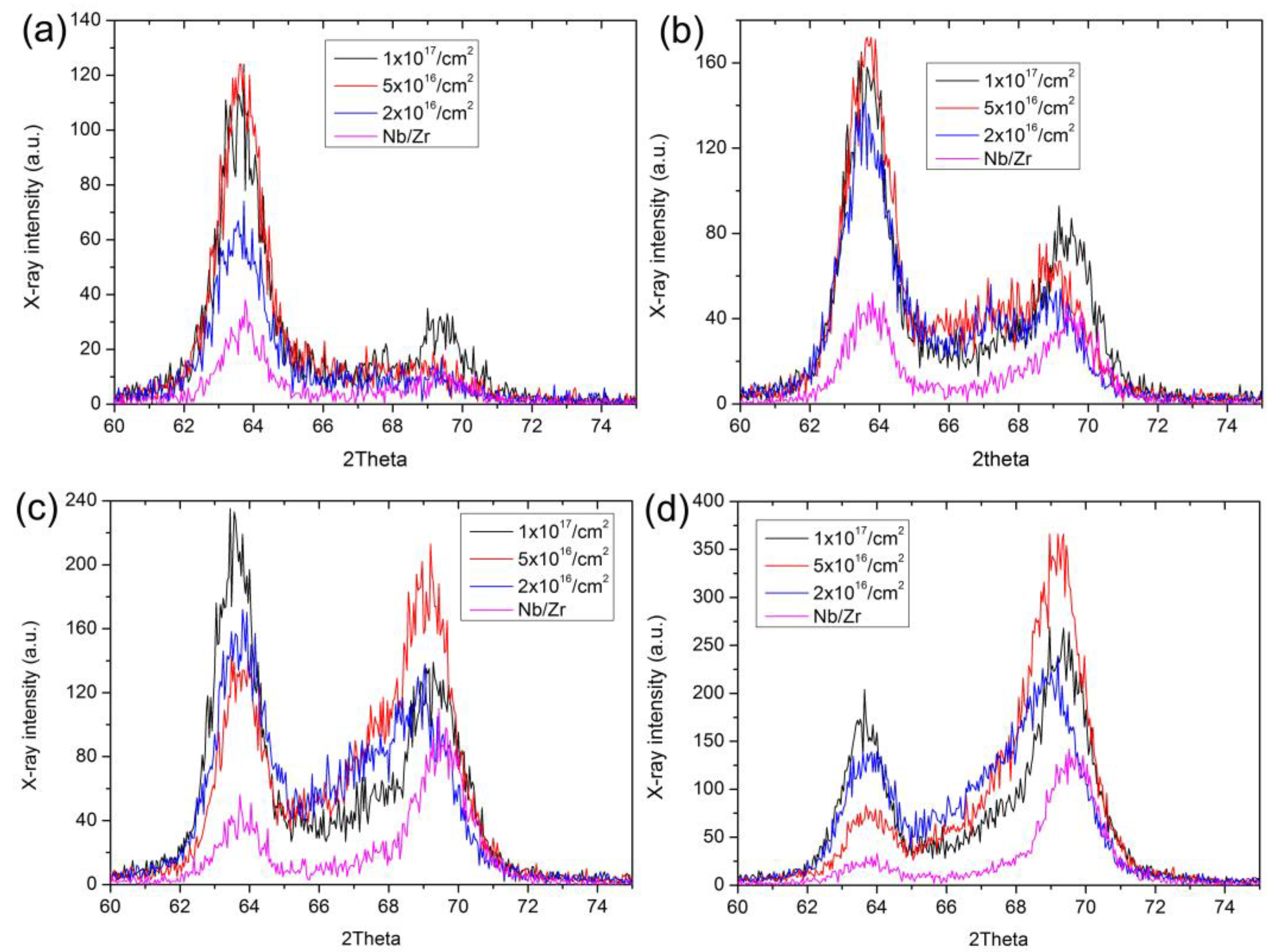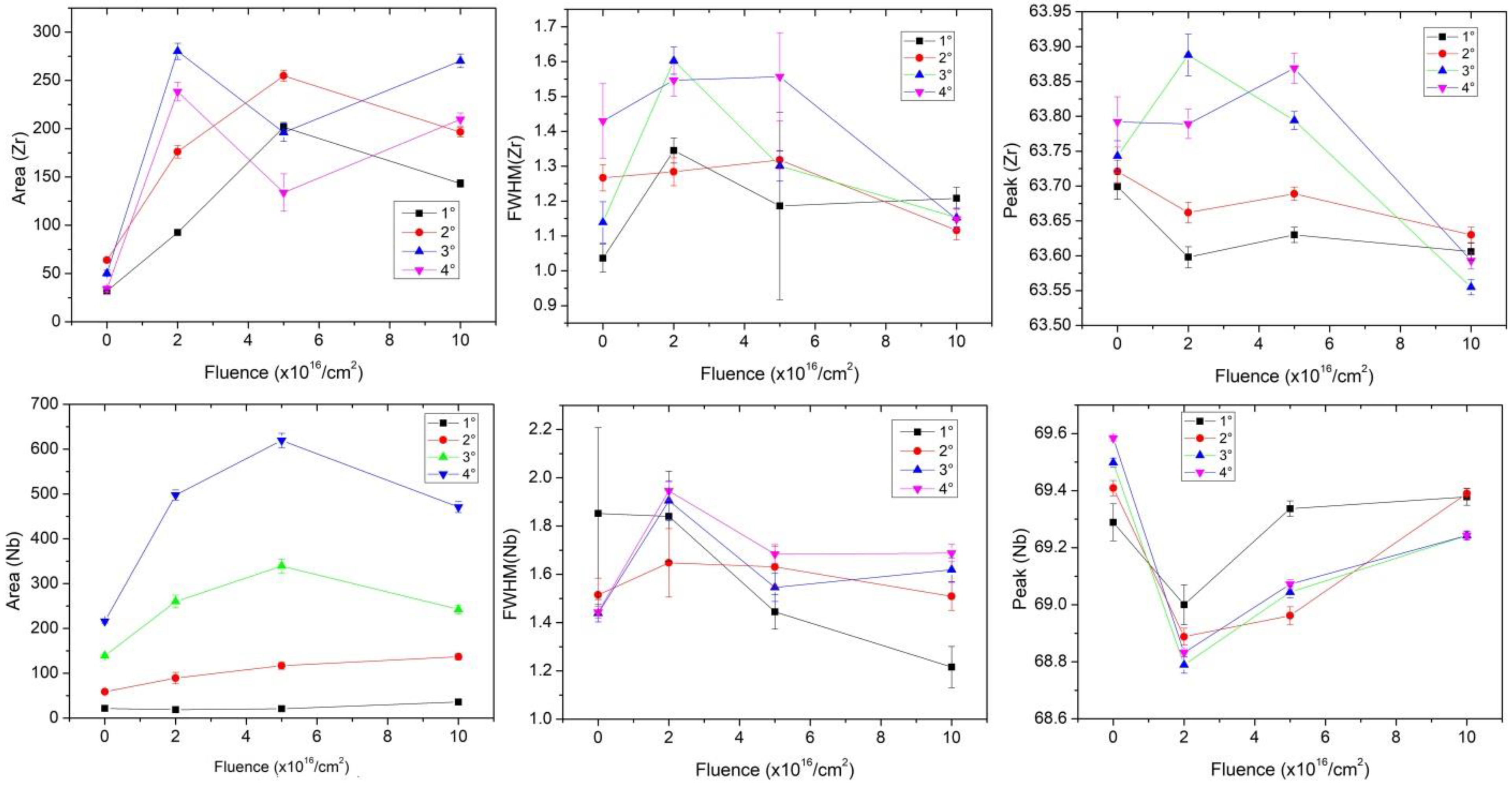Structural Properties of He-Irradiated Zr/Nb Multilayer Investigated by Grazing Incidence X-ray Diffraction
Abstract
1. Introduction
2. Experiment Process
3. Results and Discussion
4. Conclusions
- Tensile strains were formed in the Zr and Nb films, and the value of tensile strain gradually decreased with increasing depth of Zr and Nb films. Compared to Zr films, the tensile strain was easily generated and increased in the Nb films during magnetron sputtering.
- He ion irradiation-induced deposited defect annealing was found in the Zr/Nb films, and healing of pre-existing defects was more significant in the Zr films than that in the Nb films.
- The efficiency of defect annealing depends on the concentration of pre-existing defects and He fluence. When the He fluence exceeds the one for pre-existing defect annealing, residual defects will be formed, such as 1/3<110> and 1/3<100> dislocation loops in the Zr films and 1/2<111> dislocation loops in the Nb films.
Author Contributions
Funding
Data Availability Statement
Conflicts of Interest
References
- Zinkle, S.J.; Was, G.S. Materials challenges in nuclear energy. Acta Mater. 2013, 61, 735–758. [Google Scholar] [CrossRef]
- Krsjak, V.; Degmova, J.; Sojak, S.; Slugen, V. Effects of displacement damage and helium production rates on the nucleation and growth of helium bubbles—Positron annihilation spectroscopy aspects. J. Nucl. Mater. 2018, 499, 38–46. [Google Scholar] [CrossRef]
- EI-Atwani, O.; Nathaniell, J.E., II; Leff, A.C.; Muntifering, B.R.; Baldwin, J.K.; Hattar, K.; Taheri, M.L. The role of grain size in He bubble formation: Implications for swelling resistance. J. Nucl. Mater. 2017, 484, 236–244. [Google Scholar] [CrossRef]
- Kashinath, A.; Misra, A.; Demkowicz, M.J. Stable storage of helium in nanoscale platelets at semiconherent interfaces. Phys. Rev. Lett. 2013, 110, 086101. [Google Scholar] [CrossRef]
- Beyerlein, I.; Demkowicz, M.; Misra, A.; Uberuaga, B. Defect-interface interactions. Prog. Mater. Sci. 2015, 74, 125–210. [Google Scholar] [CrossRef]
- Zhang, X.; Hattar, K.; Chen, Y.; Shao, L.; Li, J.; Sun, C.; Yu, K.; Li, N.; Taheri, M.L.; Wang, H.; et al. Radiation damage in nanostructured materials. Prog. Mater. Sci. 2018, 96, 217–321. [Google Scholar] [CrossRef]
- Demkowicz, M.; Wang, Y.; Hoagland, R.; Anderoglu, O. Mechanisms of He escape during implantation in CuNb multilayer composites. Nucl. Instrum. Methods Phys. Res. Sect. B Beam Interact. Mater. Atoms. 2007, 261, 524–528. [Google Scholar] [CrossRef]
- Liu, Y.; Chen, Y.; Yu, K.; Wang, H.; Chen, J.; Zhang, X. Stacking fault and partial dislocation dominated strengthening mechanisms in highly textured Cu/Co multilayers. Int. J. Plast. 2013, 49, 152–163. [Google Scholar] [CrossRef]
- Wang, M.; Beyerlein, I.J.; Zhang, J.; Han, W.Z. Defect-interface interactions in irradiated Cu/Au nanocomposites. Acta Mater. 2018, 160, 211–223. [Google Scholar] [CrossRef]
- Yu, K.; Sun, C.; Chen, Y.; Liu, Y.; Wang, H.; Kirk, M.; Li, M.; Zhang, X. Superior tolerance of Ag/Ni multilayers against Kr ion irradiation: An in situ study. Philos. Mag. 2013, 93, 3547–3562. [Google Scholar] [CrossRef]
- Sheng, Y.B.; Zhang, H.P.; Shen, T.L.; Wei, K.F.; Kang, L.; Liu, R.; Zhang, T.M.; Li, B.S. Atomic mixing induced by ion irradiation of V/Cu multilayers. Chin. Phys. Lett. 2020, 37, 036101–036105. [Google Scholar] [CrossRef]
- Li, N.; Nastasi, M.; Misra, A. Defect structures and hardening mechanisms in high dose helium ion implanted Cu and Cu/Nb multilayer thin films. Int. J. Plast. 2012, 32–33, 1–16. [Google Scholar] [CrossRef]
- Callisti, M.; Karlik, M.; Polcar, T. Bubbles formation in helium ion irradiated Cu/W multilayer nanocomposites: Effects on structure and mechanical properties. J. Nucl. Mater. 2016, 473, 18–27. [Google Scholar] [CrossRef]
- Wei, Q.; Li, N.; Mara, N.; Nastasi, M.; Misra, A. Suppression of irradiation hardening in nanoscale V/Ag multilayers. Acta Mater. 2011, 59, 6331–6340. [Google Scholar] [CrossRef]
- Li, N.; Fu, E.G.; Wang, H.; Carter, J.J.; Shao, L.; Maloy, S.A.; Misra, A.; Zhang, X. He ion irradiation damage in Fe/W nanlayer films. J. Nucl. Mater. 2009, 389, 233–238. [Google Scholar] [CrossRef]
- Callisti, M.; Karlik, M.; Polcar, T. Competing mechanisms on the strength of ion-irradiated Zr/Nb nanoscale multilayers: Interface strength versus radiation hardening. Scr. Mater. 2018, 152, 31–35. [Google Scholar] [CrossRef]
- Dong, Q.; Qin, H.; Yao, Z.; Daymond, M.R. Irradiation damage and hardening in pure Zr and Zr-Nb alloys at 573 K from self-ion irradiation. Mater. Des. 2019, 161, 147–159. [Google Scholar] [CrossRef]
- Wang, R.; Li, P.; Li, B.; Hu, L.; Huang, F.; Huang, Q.; Ge, F. The oxidation mechanisms of the Xe20+ ion-irradiated Cr coatings on Zr alloy coupons: Accelerated diffusion and internal oxidation. Corros. Sci. 2022, 201, 110301. [Google Scholar] [CrossRef]
- Liu, H.; Feng, Y.; Yao, Y.; Li, B.; Wang, R.; Shi, X.; Li, P.; Shu, J.; Huang, F.; Huang, Q.; et al. Effect of the 345 °C and 16.5 MPa autoclave corrosion on the oxidation behavior of Cr-coated zirconium claddings in the high-temperature steam. Corros. Sci. 2021, 189, 109608. [Google Scholar] [CrossRef]
- Daghbouj, N.; Callisti, M.; Sen, H.; Karlik, M.; Čech, J.; Vronka, M.; Havránek, V.; Čapek, J.; Minárik, P.; Bábor, P.; et al. Interphase boundary layer-dominated strain mechanisms in Cu+ implanted Zr-Nb nanoscale multilayers. Acta Mater. 2021, 202, 317–330. [Google Scholar] [CrossRef]
- Callisti, M.; Lozano-Perez, S.; Polcar, T. Structural and mechanical properties of γ-irradiated Zr/Nb multilayer nanocomposites. Mater. Lett. 2016, 163, 138–141. [Google Scholar] [CrossRef]
- Liang, X.; Wang, Y.; Zhao, J.; Wu, S.; Feng, X.; Wu, K.; Zhang, J.; Liu, G.; Sun, J. Size-dependent microstructure evolution and hardness of He irradiated Nb/Zr multilayers under different ion doses. Mater. Sci. Eng. A 2019, 764, 138259. [Google Scholar] [CrossRef]
- Daghbouj, N.; Sen, H.; Čížek, J.; Lorinčík, J.; Karlík, M.; Callisti, M.; Čech, J.; Havránek, V.; Li, B.; Krsjak, V.; et al. Characterizing heavy ions-irradiated Zr/Nb: Structure and mechanical properties. Mater. Des. 2022, 219, 110732. [Google Scholar] [CrossRef]
- Radhakrishnan, M.; Kombaiah, B.; Bachhav, M.; Nizolek, T.; Wang, Y.; Knezevic, M.; Mara, N.; Anderoglu, O. Layer dissolution in accumulative roll bonded bulk Zr/Nb multilayers under heavy-ion irradiation. J. Nucl. Mater. 2021, 557, 153315. [Google Scholar] [CrossRef]
- Misra, A.; Hirth, J.P.; Kung, H. Single-dislocation-based strengthening mechanisms in nanoscale metallic multilayers. Philos. Mag. A 2002, 82, 2935–2951. [Google Scholar] [CrossRef]
- Hoagland, R.; Kurtz, R.; Henager, C. Slip resistance of interfaces and the strength of metallic multilayer composites. Scr. Mater. 2004, 50, 775–779. [Google Scholar] [CrossRef]
- Zare, A.; Su, Q.; Gigax, J.; Shojaee, S.; Nastasi, M.; Shao, L.; Lucca, D. Effects of ion irradiation on structural and mechanical properties of crystalline Fe/amorphous SiOC nanolaminates. Acta Mater. 2017, 140, 10–19. [Google Scholar] [CrossRef]
- Basha, M.; Bhatt, H.; Kumar, Y.; Prajapat, C.; Gupta, M.; Basu, S.; Singh, S. Formation of an intermetallic GdCo2 alloy on controlled annealing of a Gd/Co multilayer. Mater. Lett. 2021, 283, 128879. [Google Scholar] [CrossRef]
- Bhattacharya, D.; Karki, V.; Singh, S.; Rao, T.C. Thermal stability of interfacial mixed layers in c-Ni/a-Zr multilayer during annealing: Structural and magnetic properties. Appl. Surf. Sci. 2022, 572, 151300. [Google Scholar] [CrossRef]
- Huo, J.; Wei, M.; Ma, Y.; Cao, Z.; Meng, X. The enhanced strength and electrical conductivity in Ag/Cu multilayers by annealing process. Mater. Sci. Eng. A 2020, 772, 138818. [Google Scholar] [CrossRef]
- Zhang, Y.; Su, R.; Niu, T.; Richter, N.; Xue, S.; Li, Q.; Ding, J.; Yang, B.; Wang, H.; Zhang, X. Thermal stability and deformability of annealed nanotwinned Al/Ti multilayers. Scr. Mater. 2020, 186, 219–224. [Google Scholar] [CrossRef]
- Khosravani, M.R.; Reinicke, T. On the Use of X-ray Computed Tomography in Assessment of 3D-Printed Components. J. Nondestruct. Eval. 2020, 39, 1–17. [Google Scholar] [CrossRef]
- Roslin, A.; Marsh, M.; Piche, N.; Provencher, B.; Mitchell, T.R.; Onederra, I.A.; Lonardi, C.R. Processing of micro-CT images of granodiorite rock samples using convolutional neutral networks (CNN), part I: Super-resolution enhancement using a 3D CNN. Miner. Eng. 2022, 188, 107748. [Google Scholar] [CrossRef]
- In situ tensile damage characterization of C/C composites through X-ray computed tomography and digital volume correlation. Ceram. Int. 2023, 49, 10471–10480.
- Stress analysis of aspherical TRISO-coated particle with X-ray computed tomography. Nucl. Mater. Energy 2023, 34, 101322. [CrossRef]
- Huang, W.; Sun, M.; Wen, W.; Yang, J.; Xie, Z.; Liu, R.; Wang, X.; Wu, X.; Liu, C.; Fang, Q. He2+ irradiation induced microstructure evolution in sub-surface layer of the coarse-grained tungsten accessed by synchrotron GIXRD and GISAXS. Appl. Surf. Sci. 2022, 593, 153461. [Google Scholar] [CrossRef]
- Nastasi, M.; Mayer, J.; Hirvoven, J.K. Ion-Solid Interactions: Fundamentals and Applications; Cambridge University Press: New York, NY, USA, 1996. [Google Scholar]
- Ziegler, J.F.; Ziegler, M.D.; Beersack, J.P. SRIM-The stopping and range of ions in matter (2010). Nucl. Instr. Meth. B 2010, 268, 1818. [Google Scholar] [CrossRef]
- Rafaja, D.; Valvoda, V.; Perry, A.J.; Treglio, J.R. Depth profile of residual stress in metal-ion implanted TiN coatings. Surf. Coatings Technol. 1997, 92, 135–141. [Google Scholar] [CrossRef]
- Dutta, A.; Das, K.; Gayathri, N.; Menon, R.; Nabhiraj, P.; Mukherjee, P. Effect of Ar 9+ irradiation on Zr-1Nb-1Sn-0.1Fe alloy characterized by Grazing Incidence X-ray diffraction technique. Radiat. Phys. Chem. 2018, 144, 125–131. [Google Scholar] [CrossRef]
- Cullity, B.D.; Stock, S.R. Elements of X-ray Diffraction, 3rd ed.; Pearson Education Limited: London, UK, 2014. [Google Scholar]
- Han, Y.; Li, B.S.; Wang, Z.G. H-ion irradiation-induced annealing in He-ion implanted 4H-SiC. Chin. Phys. Lett. 2017, 34, 012801. [Google Scholar] [CrossRef]
- Zhang, Y.; Sachan, R.; Pakarinen, O.H.; Chisholm, M.F.; Liu, P.; Xue, H.; Weber, W.J. Ionization-induced annealing of pre-existing defects in silicon carbide. Nat. Commun. 2015, 6, 8049. [Google Scholar] [CrossRef] [PubMed]
- Debelle, A.; Backman, M.; Thomé, L.; Weber, W.; Toulemonde, M.; Mylonas, S.; Boulle, A.; Pakarinen, O.; Juslin, N.; Djurabekova, F.; et al. Combined experimental and computational study of the recrystallization process induced by electronic interactions of swift heavy ions with silicon carbide crystals. Phys. Rev. B 2012, 86, 100102. [Google Scholar] [CrossRef]
- Heera, V.; Stomemenos, J.; Kogler, R.; Skorupa, W. Amorphization and recrystallization of 6H-SiC by ion-beam irradiation. J. Appl. Phys. 1995, 77, 2999. [Google Scholar] [CrossRef]
- Jiang, S.; Zhu, R.; Hu, X.; Zhang, J.; Huang, Z. The Preparation of Amorphous ZrC/Nanocrystalline Ni Multilayers and the Resistance to He+ Irradiation. Materials 2022, 15, 3059. [Google Scholar] [CrossRef]
- Ferré, F.G.; Mairov, A.; Ceseracciu, L.; Serruys, Y.; Trocellier, P.; Baumier, C.; Kaïtasov, O.; Brescia, R.; Gastaldi, D.; Vena, P.; et al. Radiation endurance in Al2O3 nanoceramics. Sci. Rep. 2016, 6, 33478. [Google Scholar] [CrossRef]
- Daghbouj, N.; Sen, H.; Callisti, M.; Vronka, M.; Karlik, M.; Duchoň, J.; Čech, J.; Havránek, V.; Polcar, T. Revealing nanoscale strain mechanisms in ion-irradiated multilayers. Acta Mater. 2022, 229, 117807. [Google Scholar] [CrossRef]
- Sen, H.; Polcar, T. Helium migration in Zr-Nb multilayers under electric field. J. Nucl. Mater. 2021, 555, 153133. [Google Scholar] [CrossRef]





| Fluence (×1016/cm2) | Incident Angle(°) | Area(Zr) | Area(Nb) | FWHM(Zr) | FWHM(Nb) | Peak(Zr) | Peak(Nb) |
|---|---|---|---|---|---|---|---|
| 0 | 1 | 31.9 ± 1.2 | 21.6 ± 4.9 | 1.04 ± 0.04 | 1.85 ± 0.36 | 63.699 ± 0.018 | 69.289 ± 0.065 |
| 2 | 92.4 ± 2.7 | 18.8 ± 2.1 | 1.35 ± 0.04 | 1.84 ± 0.19 | 63.598 ± 0.015 | 69 ± 0.07 | |
| 5 | 201.6 ± 5.0 | 20.7 ± 6.4 | 1.19 ± 0.27 | 1.45 ± 0.07 | 63.63 ± 0.011 | 69.337 ± 0.027 | |
| 10 | 143.2 ± 4.1 | 35.8 ± 3.2 | 1.21 ± 0.03 | 1.22 ± 0.09 | 63.606 ± 0.012 | 69.378 ± 0.029 | |
| 0 | 2 | 63.8 ± 2.1 | 59 ± 3.2 | 1.27 ± 0.04 | 1.52 ± 0.07 | 63.721 ± 0.016 | 69.409 ± 0.027 |
| 2 | 176.2 ± 6.5 | 89.3 ± 12 | 1.28 ± 0.04 | 1.65 ± 0.14 | 63.66 ± 0.015 | 68.888 ± 0.03 | |
| 5 | 254.8 ± 5.9 | 116.7 ± 7.6 | 1.32 ± 0.03 | 1.63 ± 0.09 | 63.689 ± 0.01 | 68.962 ± 0.031 | |
| 10 | 196.5 ± 5.1 | 136.8 ± 7 | 1.12 ± 0.03 | 1.51 ± 0.06 | 63.63 ± 0.011 | 69.39 ± 0.018 | |
| 0 | 3 | 50.3 ± 3.1 | 139.1 ± 3.7 | 1.14 ± 0.06 | 1.44 ± 0.04 | 63.743 ± 0.022 | 69.498 ± 0.016 |
| 2 | 280.2 ± 8.4 | 260.2 ± 14.2 | 1.6 ± 0.04 | 1.91 ± 0.08 | 63.888 ± 0.03 | 68.700 ± 0.029 | |
| 5 | 196.1 ± 9.4 | 339.4 ± 15.6 | 1.3 ± 0.04 | 1.55 ± 0.06 | 63.794 ± 0.013 | 69.044 ± 0.02 | |
| 10 | 270.3 ± 7 | 242.5 ± 9.9 | 1.15 ± 0.03 | 1.62 ± 0.05 | 63.555 ± 0.011 | 69.243 ± 0.016 | |
| 0 | 4 | 33.9 ± 3.3 | 215.9 ± 3.8 | 1.43 ± 0.11 | 1.44 ± 0.02 | 63.792 ± 0.036 | 69.584 ± 0.01 |
| 2 | 238.3 ± 9.6 | 497.7 ± 11.4 | 1.55 ± 0.05 | 1.95 ± 0.04 | 63.789 ± 0.021 | 68.032 ± 0.013 | |
| 5 | 133.9 ± 19.3 | 619.6 ± 16 | 1.56 ± 0.13 | 1.68 ± 0.04 | 63.869 ± 0.022 | 69.072 ± 0.016 | |
| 10 | 209.7 ± 6.8 | 470.8 ± 12.3 | 1.15 ± 0.03 | 1.69 ± 0.04 | 63.593 ± 0.012 | 69.243 ± 0.013 |
Disclaimer/Publisher’s Note: The statements, opinions and data contained in all publications are solely those of the individual author(s) and contributor(s) and not of MDPI and/or the editor(s). MDPI and/or the editor(s) disclaim responsibility for any injury to people or property resulting from any ideas, methods, instructions or products referred to in the content. |
© 2023 by the authors. Licensee MDPI, Basel, Switzerland. This article is an open access article distributed under the terms and conditions of the Creative Commons Attribution (CC BY) license (https://creativecommons.org/licenses/by/4.0/).
Share and Cite
Wang, T.; Li, B.; Li, J.; Wei, H.; Zhou, J.; Dong, P.; Li, J.; Krsjak, V. Structural Properties of He-Irradiated Zr/Nb Multilayer Investigated by Grazing Incidence X-ray Diffraction. Crystals 2023, 13, 451. https://doi.org/10.3390/cryst13030451
Wang T, Li B, Li J, Wei H, Zhou J, Dong P, Li J, Krsjak V. Structural Properties of He-Irradiated Zr/Nb Multilayer Investigated by Grazing Incidence X-ray Diffraction. Crystals. 2023; 13(3):451. https://doi.org/10.3390/cryst13030451
Chicago/Turabian StyleWang, Tao, Bingsheng Li, Jun Li, Haiyuan Wei, Junjun Zhou, Pan Dong, Jie Li, and Vladimir Krsjak. 2023. "Structural Properties of He-Irradiated Zr/Nb Multilayer Investigated by Grazing Incidence X-ray Diffraction" Crystals 13, no. 3: 451. https://doi.org/10.3390/cryst13030451
APA StyleWang, T., Li, B., Li, J., Wei, H., Zhou, J., Dong, P., Li, J., & Krsjak, V. (2023). Structural Properties of He-Irradiated Zr/Nb Multilayer Investigated by Grazing Incidence X-ray Diffraction. Crystals, 13(3), 451. https://doi.org/10.3390/cryst13030451







